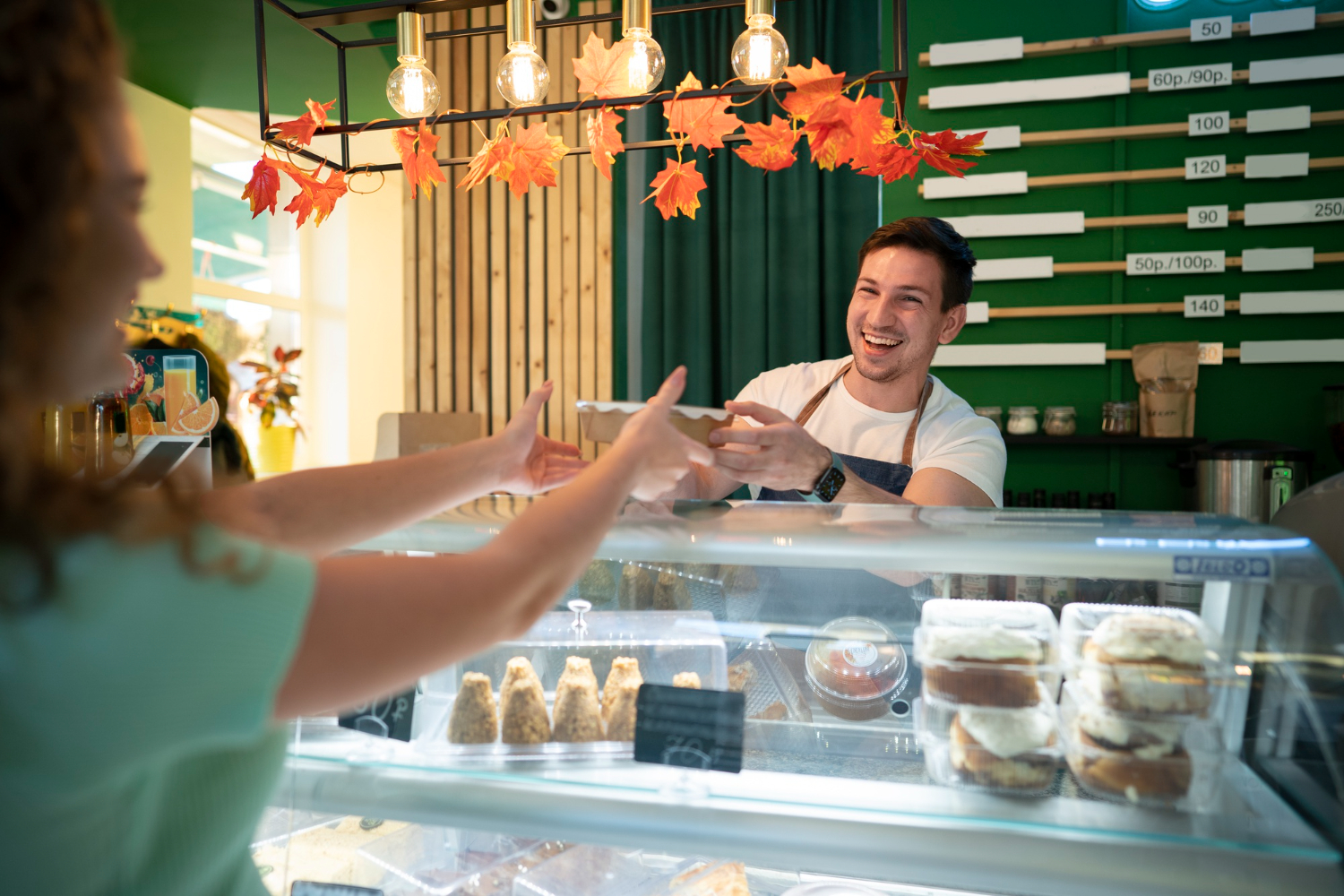
By Bella Zhang July 30, 2025
Running a small bakery is a delicate blend of passion and practicality. On one side, there’s the creativity of crafting fresh bread, cakes, and pastries. On the other, there’s the daily grind of operations, inventory, staff management, and, of course, accepting payments. With the rise of digital payment and contactless cards, even the smallest bakeries now need to keep up with changing consumer expectations. Gone are the days when cash was king. Today’s customers want flexibility and speed, especially when grabbing a coffee and croissant on the go. That means offering multiple payment methods is no longer optional. Thankfully, technology is making it easier and more affordable for small food businesses to keep up.
Why Payment Flexibility Matters in Bakeries
The bakery business is built on repeat customers and impulse buys. People pop in for a quick bite or to grab a gift and if they can’t pay the way they want to, you might lose that sale. Accepting digital payments isn’t just about convenience, it’s about survival in a cash-light world. Customers expect to pay with cards, mobile wallets or QR codes. Whether it’s a tap and go from a smartwatch or a Venmo scan you need to meet them where they are. This expectation isn’t just for cities but for small towns too as digital habits spread across all demographics.
Upgrading your payment setup doesn’t mean turning your bakery into a tech hub. It means making small thoughtful changes that match how people shop today. And with free payment equipment and software now available to small businesses the barriers to entry are lower than ever.
Getting Started with Free Payment Equipment
Many payment processors offer free payment equipment as part of their onboarding package for small businesses. This includes card readers, countertop terminals, or mobile swipers that accept chip, swipe, and contactless payments. These devices are often provided at no upfront cost in exchange for a service agreement or transaction fees. For a bakery owner, this can be a game changer. Instead of investing hundreds of dollars in hardware, you can start accepting digital payments with minimal risk. These terminals are typically compact, easy to set up, and designed for fast-paced environments like bakeries.
When choosing a provider, look for one that includes customer support, app integrations, and detailed reporting. Free hardware is helpful, but what truly empowers your bakery is how well that device connects to the rest of your tools. Smooth checkout processes and real-time sales tracking can make a big difference in your daily operations.
Popular Digital Payment Methods for Bakeries
Customers use many digital payment options. You should accept the ones that are most popular in your area. That’s credit and debit cards, mobile wallets like Apple Pay and Google Pay, and peer to peer like PayPal and Venmo. With small bakery digital tools you can set up a system that accepts all of these without adding complexity. Many all in one terminals now support multi method acceptance so you never have to turn away a customer because of payment limitations.
Also QR code payments are becoming more popular especially for table service or self checkout models. A simple printed QR code that leads to a secure payment link can speed things up and reduce physical contact making the process more hygienic and efficient. By going digital bakeries can serve more customers and adapt to trends in real time. You stay competitive without having to overhaul your entire business model.
Mobile POS Solutions for On-the-Go Sales
Many bakeries also sell at farmers’ markets, food festivals, or pop-up events. In these environments, flexibility and portability are key. That’s where mobile POS systems come in handy. These systems often include a mobile card reader connected to a tablet or smartphone, allowing you to take payments anywhere.
Some companies offer free payment equipment with mobile POS compatibility. These tools are perfect for bakery owners who operate outside a fixed storefront. They also help streamline inventory and sales tracking across locations, giving you a single dashboard to view your entire business. The convenience of mobile POS means no more fumbling with cash or missing out on sales due to payment limitations. You’re always ready to accept payment, whether you’re behind your counter or serving a customer under a festival tent.
Integrating Digital Payments with Other Bakery Tools
Digital payments are only one piece of the puzzle. The real value comes when you integrate them with other small bakery digital tools like inventory software, customer loyalty programs, or online ordering systems. This creates a seamless flow of information and reduces repetitive tasks. For example, when a customer pays with a card, that sale can be automatically recorded in your inventory tracker. If the purchase qualifies for a loyalty point or discount, your system can apply it without manual entry. Over time, this reduces mistakes and frees up your team to focus on service.
Some platforms also allow customers to order ahead and pay online. These systems sync with your POS so that pickup orders can be handled without any added stress. It’s all about streamlining your operations while keeping your customer experience smooth and modern.
Building Customer Trust with Secure Transactions
Security is top of mind for today’s customers. When someone swipes a card or uses a mobile wallet they want to know their info is safe. Good news is most free payment equipment from reputable providers comes with built in security features like encryption and tokenization. As a business owner you benefit too. Secure systems protect you from chargebacks, fraud and data breaches. Make sure your terminal is PCI compliant and your software provider is up to date. Displaying badges or signs that say “Secure Payments Accepted” can also put nervous customers at ease.
Transparency about your payment process helps build trust. If your customers see you’re using modern safe tools they’ll be more likely to shop with you. In a small business like a bakery that trust can turn one time visitors into repeat customers.

Supporting Contactless and Touch-Free Payments
Contactless payment has become the standard in many locations, especially after recent global health concerns. Touch-free payments reduce physical contact, speed up transactions, and offer an added layer of safety for both customers and staff. Accepting contactless cards or tap-enabled phones is easy with most free payment equipment. You simply hold the terminal near the customer’s device and the payment is processed within seconds. No PIN entry. No signature. No contact.
This upgrade doesn’t just protect health, it also enhances speed and convenience. In busy bakeries where every second counts, faster payment processing means shorter lines and more satisfied customers.
Offering Payment Options for Online Orders
Even if you’re primarily a walk-in bakery, offering an online ordering option expands your reach. People might want to pre-order cakes, schedule deliveries, or pay ahead to save time. Digital payment tools make this possible without needing an elaborate ecommerce setup. Platforms like Square, Shopify, or Toast let you create simple online menus with built-in payment processing. Customers can browse, order, and pay through their phone or computer. You receive the order in real time and start preparing it for pickup or delivery.
Integrating online payment tools with your in-store POS ensures that all sales are recorded in one system. This makes bookkeeping easier and helps track trends across both digital and physical channels. For small bakeries trying to stay competitive, this kind of hybrid approach, physical and digital, is key to long-term sustainability.
Reducing Costs While Upgrading Systems
One concern many small bakery owners have is cost. But free payment equipment helps eliminate the upfront expense. While there may still be transaction fees or monthly service charges, the barrier to entry is significantly lower. Many providers also offer discounted rates for small businesses or flat-fee structures that are easier to predict. This kind of pricing transparency helps you plan better and avoid surprise charges.
By using bakery payment upgrades that align with your size and sales volume, you can gain efficiency without overspending. Often, the savings in time, error reduction, and customer satisfaction more than make up for any minimal processing costs. Upgrading doesn’t have to mean replacing everything. Sometimes it’s about layering new tools onto what already works. This gradual approach allows you to stay financially stable while improving steadily over time.
Training Staff on New Payment Systems
Introducing digital payments requires a bit of staff training, especially if your team is used to a cash-only setup. Thankfully, most small bakery digital tools are user-friendly and come with intuitive interfaces. Training should cover how to process different payment types, how to handle errors, and how to respond to customer questions. It’s also important to train staff on what to do in case of connectivity issues or failed transactions.
Clear protocols make everyone feel more confident. The fewer hiccups at checkout, the smoother the customer experience. Make sure your provider offers phone support or live chat in case you need help on the spot. Remember, well-trained staff aren’t just efficient, they also make customers feel cared for and understood, which is invaluable in a local bakery setting.
Keeping Up with Payment Trends
Digital payment technology is always evolving. Keeping up with trends helps small bakeries stay ahead of customer expectations. Whether it’s offering buy-now-pay-later options, sending digital receipts, or enabling tipping via touchscreen, every small feature adds to your appeal.
Using small bakery digital tools that are regularly updated ensures you’re not left behind. Choose partners and software that evolve with the market and offer integrations with new payment methods as they emerge. You don’t have to adopt every new feature all at once. Focus on what your customers use most and expand gradually. Listening to feedback and staying curious will help you grow smartly and sustainably.
Conclusion
Modern bakeries need digital payment systems to stay competitive. Free tools and cloud-based POS platforms make upgrades affordable and easy. These changes improve customer experience, speed, and security. With efficient payments, bakers can focus on their craft; creating delicious products while growing their business through better service and streamlined operations.